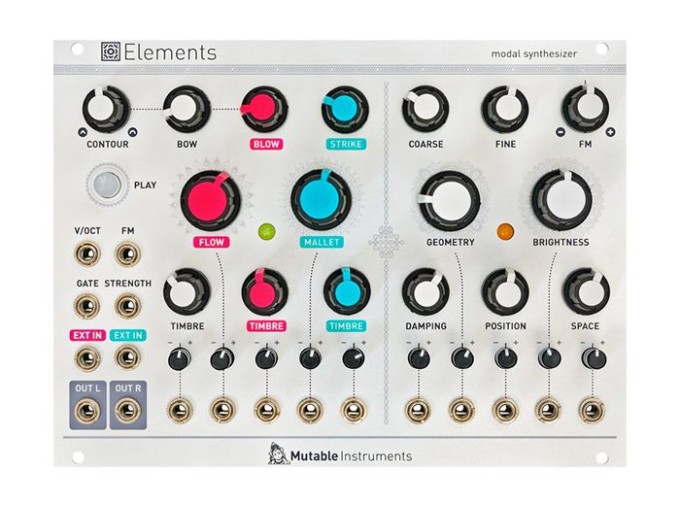Mutable Instruments Elements
Mutable Instruments Elements is a whole new synthesis realm for Eurorack modular synths. It uses a synthesis technique called Modal Synthesis, which attempts to physically model certain instruments by an exciter module being fed into a resonator module. The exciter part of the module is a complex noise generator that produces common types of noise:
- Bowing – the sound of hairs scraping against a string, like a violin.
- Blowing – the sound of air blowing past reeds or through mouth pieces, like a flute or horn.
- Striking – the sounds of an object hitting a material, like a drum or bell.
All of these types of noises can be mixed, as well as modulated for a wide variety of natural noises.
The noise generated by the exciter can then be fed through the Resonator section, which also has physical models of resonator types ranging from harmonic type resonances, such as strings, to inharmonic type resonances like that of metal tubes, bells, or glass. The resonator type is controlled with the Geometry knob. The damping control decides how "resonant" the resonator section would be. At full resonance, it drones like a string being constantly bowed, or a horn being constantly blown. At lower levels, it will ring out like a bell or cymbal, and at its lowest level, provides some timbral character to the noise. The brightness control is a lowpass filter to apply a dampening if necessary.
The position control has a similar effect to changing the location of where the string is plucked, or where the drum was hit on the head. More towards the end, or sides, gives higher harmonics more presence, with the fundamental slightly dulled, and as it moves more into the "sweet spot" of the instrument, resonates the fundamental with less higher harmonics. It has a built-in "wavetable" envelope, with many shapes internally saved. These envelopes are changed with the Contour knob, and triggered with either the Play button, or a gate input. The Space knob adjusts its stereo spread and reverb amount.
Due to the digital nature of Mutable Instruments Modules, Elements has the ability to be reprogrammed. These programs include other resonator types (modeled from those of the Rings module), as well as a Dual Operator Mono FM synth voice called Ominous Mode. See Mutable Instruments website for more details.
Mutable Elements Features
- Three generators with mixer: bowing noise, blowing noise, percussive impulses.
- Envelope contour for bowing and blowing.
- Bowing noise generator: particle-like scratching noise with 2-pole low-pass filter.
- Blowing noise generator: granular pitched noise with wavetable-like scanning between various tone colors.
- Percussive impulse generator: interpolates through a collection of impulsive excitations – including sampled sticks, brushes and hammers, and models of damped mallets, plectrums, or bouncy particles. 2-pole low-pass filter and pitch control.
- Internally uses 64 zero-delay feedback state variable filters.
- Coarse, fine and FM frequency controls.
- Geometry: Interpolates through a collection of structures, including plates, strings, tubes, bowls.
- Brightness. Specifies the character of the material the resonating structure is made of – from wood to glass, from nylon to steel.
- Damping. Adds damping to the sound – simulates a “wet” material or the muting of the vibrations.
- Position. Specifies at which point the structure is excited.
- Space. Creates an increasingly rich stereo output by capturing the sound at two different points of the structure, and then adds more space through algorithmic reverberation.
- All exciter and resonator parameters have a dedicated CV input with attenuverter.
- 1V/Oct input for controlling main resonator frequency.
- FM input.
- Gate input.
- Strength input, for amplitude control of the exciter section.
- Pre- and post- exciter envelope external audio inputs.
- Stereo audio output, with adjustable width/reverberation. It is also possible to output the raw exciter signal on one channel, and the raw resonator signal on the other.
- Input impedances: 100k.
- CV range: +/- 8V. CVs outside of this range are simply clipped.
- Audio acquisition and restitution: 16-bit, 32kHz (Kindly note that Elements’ synthesis method is inherently band-limited; and that the module synthesizes “full-bodied” sounds – the choice of 32kHz is deliberate and should not be seen as a limitation).
- Internal computations on 32-bit floating point numbers.
- Open-source hardware and firmware.
- Easy firmware updates through an audio interface.
- Cortex-M4 ARM processor.
- 34-HP.
- Current consumption: +12V: 130mA ; -12V: 10mA.

